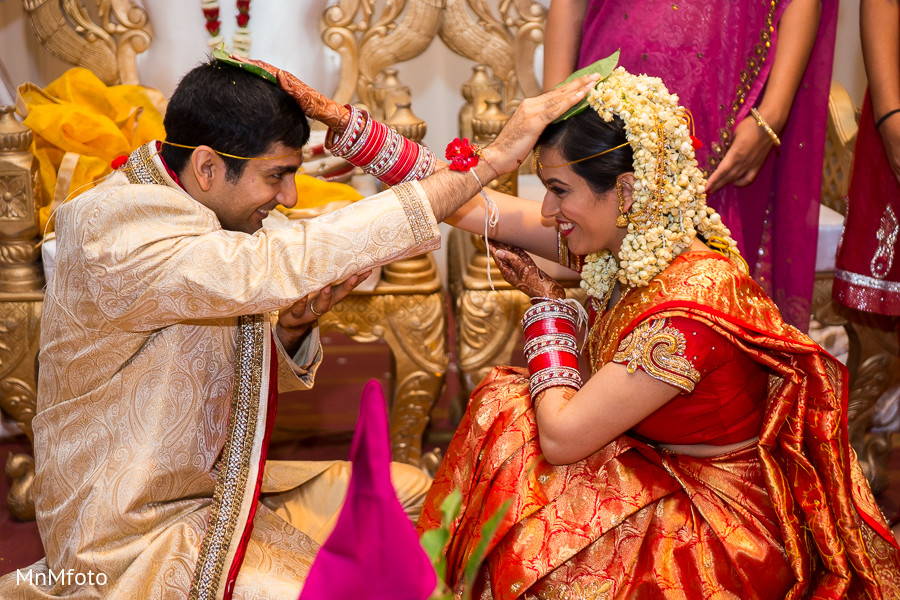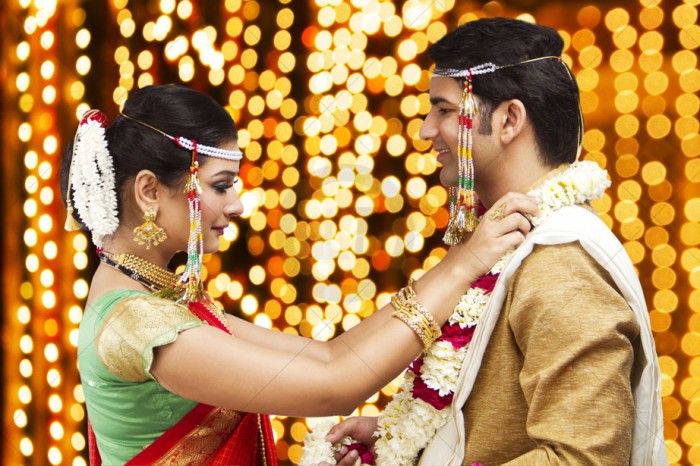Wedding Planning Institute in Delhi
Indian wedding can be broadly based on Region and Religion. Since we all know India 

North Indian weddings also follow a lot of rituals and customs. North Indian wedding traditions include many rites and rituals performed on the D-day. In traditional North Indian weddings, the main ceremony takes place at the brides' home. There are many pre-wedding and post-wedding ceremonies as well. The most important of the former is the Mangni or Sagai or engagement ceremony. On the auspicious day of the wedding, the bride's father treats the groom to yogurt and honey and graciously welcomes him into the household. One of the most important of North Indian wedding traditions is the exchanging of garlands, commonly referred to as the Jaimala ceremony and is symbolic of accepting one another. The ceremonial fire or Havan is lit and Agni is invoked to witness the occasion. Fire is regarded as a purifying element in Hindu rites and rituals. The couple then offers sacrifice or Rajaham to the fire. This is typical to North Indian wedding traditions. The ritual that follows next is the Gath Bandhan, symbolic of eternal ties. Then it is the turn of what is regarded as the most important all North Indian wedding traditions - the Saat Phere or Mangal Phere. The bride and groom circle the fire often holding hands and take vows to be beside each other throughout their lives. Both sets of parents and other elders of the family then bless the newly wedded couple. North Indian wedding traditions also include putting on the Mangal Sutra as well and application of vermillion on the bride's head by the groom. These rituals have a deeper symbolic relevance and a certain quaint charm and appeal. It is no wonder then that they enamor even foreigners.
SOUTH INDIAN WEDDINGS

The Hindu wedding ceremony has a number of rituals and customs, each symbolic of beautiful and noble sentiments. South Indian wedding traditions and ceremonies are no exception. As one enters the place or venue of ceremony of a South Indian wedding, one notice things such as full-grown plantain trees tied to both the gateposts, festoons overhead of mango leaves, and screw-pine petals that never fade, notes of the Nadaswaram, the South Indian Shehnai, Kolam or Rangoli designs at the doorsteps and the like. On the evening prior to the wedding day, the bridegroom is brought in a procession from a temple in a flower-adorned ride. The bride's parents escort him to the marriage Mandapam. Nadaswaram band leads the way along the streets. After reaching the marriage hall, there is a formal ceremony of espousal. Ganapati, the God of Initiation is invoked, to keep away all hindrances. There are several presiding gods - the Nandi Devatas. To please them, a leaf-laden branch of the Pipal tree is set up, and 5 married ladies perform a ritual of washing it with milk. This Puja or worship is followed by a presentation of a dhoti, and a saree to the espousing couple. This is performed to propitiate the 9 astral planets that rule over human destiny. The marriage ceremonies start with the Vratham performed separately by the bride and the groom. For the bride, it means the tying of the holy thread on her wrist that is meant to keep away all evil spirits. From there on, the groom prepares himself for a new chapter in his life as a householder or Grihastha. The days of his bachelorhood are now over and the acceptance of this is all that the Vratham is about. At the marriage hall, the bride's father and the bridegroom's father facing each other, formalize the final betrothal ceremony, as the Vedic priest chants the appropriate hymns in which the names of the bride, the bridegroom, as well as the names of their 3 generations of ancestors are cited in the presence of all the friends, relatives, and guests. The bride and the groom are lifted to the shoulders of their respective uncles, and in that position, they exchange flower garlands with each other thrice for a perfect union. Here the exchange of garlands symbolizes their union. It is also symbolic of acceptance of each other by exchanging the very fragrance of the other. The bride is made to sit on her father's lap and is given away as a gift by him to the bridegroom. On the girl's head, a ring made with Kusa, is placed, and over it is placed the Mangal Sutra on the opening of the yoke, and water is poured through the aperture. The bride is then given an auspicious washing, and an elite new Koorai Saree is draped around her, which is done by the sister of the bridegroom. Three knots are tied, the first one by the bridegroom, the other two knots by his sister to make the bride a part of the boy's family. The groom holds the hand of the bride. Holding the bride's hand, the bridegroom walks seven steps with her. This is the most important part of the marriage ceremony, and only when they walk seven steps together with is the marriage complete. The belief is that when one walks seven steps with another, one becomes the other's friend. A vital part of the wedding is the honor paid by the couple to Agni, the fire god. They circle around the fire and feed it with ghee, and twigs of nine types of trees, as sacrificial firewood. The vapors that arise, are supposed to possess therapeutic, healing and purification properties for the couple. Agni, the most powerful element in the cosmos is deemed as a witness to the marriage. The bridegroom helps her tread on a grindstone kept on the right side of the fire, holding the bride's left foot toe. The elders and the invitee's shower Akshadai, or rice-grains coated with turmeric and saffron, on the couple, as approval. Taking with her, fire from the Laaja Homam, the bride leaves her home and enters the new home of her in-laws. The Vedic hymns sound like a mother's words of advice to her daughter. The evening of the marriage day is a time to relax and rejoice. The newly married wife calls her husband for play, alluring him through a song. Much to the cheerfulness of one and all gathered there follows a list of playful items. During these items, the ladies sing songs poking fun at the bride, the groom, and the in-laws. These proceedings bring out many qualities of the bride and the groom, such as sporting spirit, kindness, strength, co-operative nature and the like. A solution of lime and turmeric powder, is prepared on a plate, and circled around, and thrown away to keep the evil eye at bay. This is done a number of times during the entire wedding ceremony, and also at the end.
EAST INDIAN WEDDING

Hindu weddings are ceremonial feasts laden with symbolic rites and rituals. Despite India's diversities in language, culture, food, and lifestyle, one can observe common threads in many Hindu weddings across the nation. The East Indian wedding traditions mainly include the marriage traditions of West Bengal, Orissa, Assam and other northeastern states of India. Bengali wedding ceremonies consist of simple but meaningful rituals. There are plenty of interesting Bengali wedding traditions and customs, which enable close friends and relatives to come together and share joyous moments while celebrating the union of two souls. When the marriage procession of the groom arrives at the entrance of the bride's residence, all of them are given a hearty welcome with fresh flowers. The Baran Dala is touched to the groom's forehead by an elderly female relative of the bride, and then to the ground. This gesture stands for a portion of blessing. Then, the groom is offered sweets and sherbet. As the groom gets into the bride's house or wedding venue, rosewater is sprinkled on him. The Shubho Drishti ritual is performed when the bride and groom first look at each other. The Mala Badal ceremony is the exchange of flower garlands between the bride and groom along with the chants of mantras. As a part of Saat Paak ritual, the bride has to sit on a low wooden stool called Pidi that is lifted by her brothers. Then, the girl is taken around the groom seven times in circles, which symbolizes their union. During the Sampradhan ritual, the bride's responsibility is given to the groom by her paternal or maternal uncle. After this, the Saptapadi ritual takes place. The Basar Ghar ceremony is a custom in which the newlyweds are given a warm welcome in the bride's house and are served a delectable dinner. During the Bashi Biye ritual, the next morning after the wedding, the groom applies vermilion on his wife's forehead. Then the newly married couple visits the Mandap, and worship the Sun God. During the Bidaai Ceremony, the newlyweds leave for their home, after being blessed by all the elders. The Bou Baran ritual is performed to give an affectionate welcome to the newlyweds in the groom's house. The wife of the groom's elder brother carries a plate containing Alta and milk and places it under the bride's feet. The bride then has to enter the house escorted by her sister-in-law. The imprints of her feet on the floor of the house are preserved for a while. She also receives blessings from all the members of the house. In the Bou Bhat ceremony, the bride serves the members of the house and eats her first meal in her husband's house. A reception party hosted by the groom's family mostly takes place in the evening.
WEST INDIAN WEDDING





